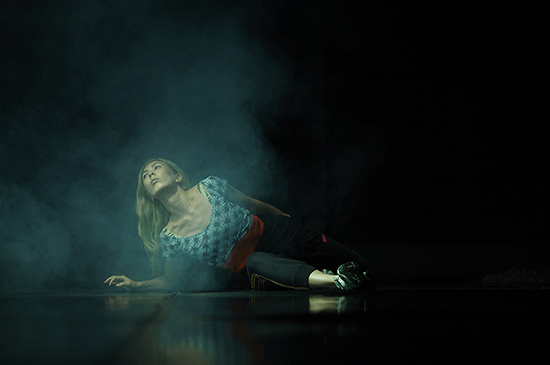Next Wave Festival: The fantastical power of the everyday
Chloe Chignell: Desert Body Creep

Angela Goh, Desert Body Creep, Next Wave 2016
photo Zan Wimberley
Angela Goh, Desert Body Creep, Next Wave 2016
Walls lined in grey metal, hanging cords, piled fabric and electronics litter the space; I am in the carcass of a theatre. Angela Goh stands casually, fully illuminated, the theatre baring its skeleton; what expectations can I have of something so dead?
In a “post post-everything world” (cited by Goh in the Next Wave program guide), we are left (and begin) with an endless expanse of time. A wasteland of used parts, the theatre sags. What came before? And what is left? Desert Body Creep moves without urgency, Angela Goh performs with clarity, patience and endurance; she seems not to make promises.
In this work, choreography is understood as the assemblage of elements: the body becomes a material, much like the space, lighting and sound. A series of images and scenes is constructed through careful marriage of sound, object and body. In a powerful moment, Goh sits with microphone in hand, mouth open, to sound a long high note. It strikes me as a visceral gesture, her physicality so involved in this simple and haunting scene. A looping echo multiplies into a body of sound.
A sense of excavation pervades the space, moving beneath the ground and below the skin. The dancer executes a continuous backward roll and burrows under a floating smoke landscape. The body grinds down, inverting the dancerly ideal of flight into that of digging. In another scene, a series of erratic passages across the space, Goh crawls under the sheets of fabric, momentarily becoming monster or ghost.
The long green worm-girl slowly labours across the space, making no apologies, continuing and continuing. A brief pause as the body contorts inside the fabric, then labouring, labouring, until it digests the last piece of fabric. The feeding leaves me exhausted, the worm rests heavy; so do I. The mouth opens once more and Goh crawls out, now nude. Suddenly the worm seems much larger. The body looks tiny as the flesh emerges, all heaviness left inside the deflated green tube.
A guitar solo blasts as Goh steps onto an electronic wobble board, her flesh in a furious shake. Sound ceases. Goh presses a button increasing the machine’s speed, and sound returns. Each element in this scene is given the time it needs. As the pause-click-and-play repeats, the flesh ripples furiously. And I notice myself calling it ‘the flesh’, becoming detached from Goh, who’s now a vibrating light pink mass in the formation of a body.
When I watch dance I find myself looking for what the piece is asking of me: how am I being asked to participate? Am I performing my role? Yet during Desert Body Creep, I realised I was, in fact, fine just where I was; our relationship was simple, I was there and so was Angela Goh. I felt comfortable at a distance, I didn’t need to go ‘into’ the work; illusion was of no interest, but instead what became important was a fiction located firmly in the actual. Constructed with stark visibility, the scenes dealt in real affect—absurd images in real space and real time. As Goh slid inside a long green velour tube and began to eat piles of fabric, she didn’t become a worm, but remained girl-as-worm, feeding on dead costumes. I felt a desire to believe in the transformation, to slip into the imaginary, but the performance did not ask that of me. It was far more absurd and revealing to remain in the actual.
It was all right there before us, a fiction so mundane it became unbelievable. If the imaginary implies a certain elevation from the actual, Desert Body Creep uses fiction to burrow down—a deep fantasy. With sharp persistence Desert Body Creep avoided illusion, posing an interesting problem: what is left to imagine in a post post-everything world? Does fantasy now lie in the actual? A girl, in a worm, eating fabric?
–
Next Wave Festival 2016: Desert Body Creep, choreographer, performer Angela Goh, sound design Matt Cornell; Northcote Town Hall, Melbourne, 17-22 May
Chloe Chignell is an artist working with dance and choreography in an expanded field. She is co-curator of Dance Speaks, was assistant editor of Dancehouse Diary and developed Indigo Dance Magazine through Performing Arts Forum, France.
This review was written in the DanceWrite dance reviewing workshop. Read more reviews here.
DanceWrite was conducted by RealTime editors Keith Gallasch and Virginia Baxter with mentors Andrew Fuhrmann and Jana Perkovic. The workshop was an initiative of Hannah Matthews as part of her Australia Council-funded Sharing Space program and was presented in collaboration with Next Wave Festival and RealTime.
RealTime issue #132 April-May 2016






